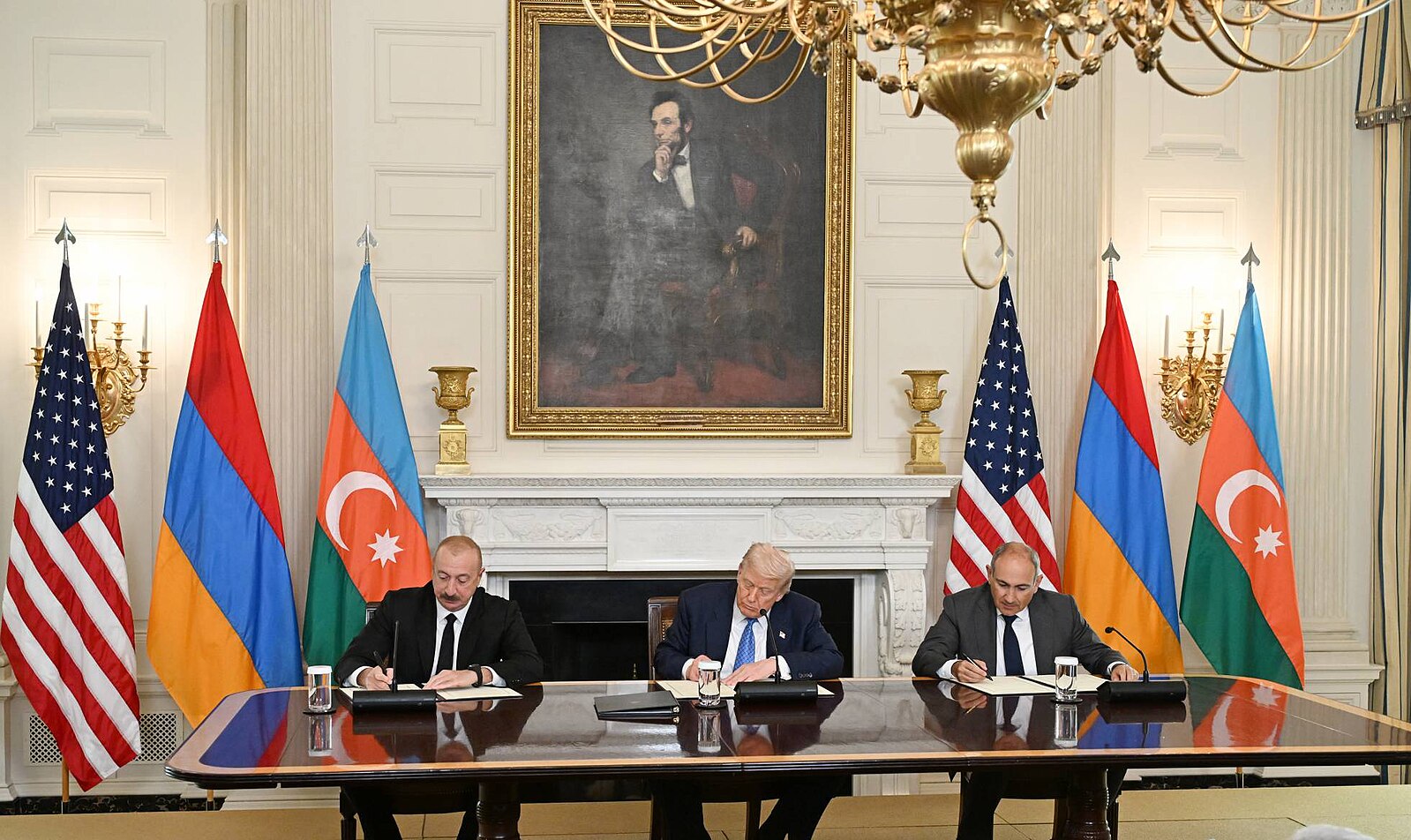By Stephen Blank
In Washington on August 8, 2025, the presidents of Armenia and Azerbaijan signed what amounts to a framework for a peace treaty. The agreement ratified both sides’ support for creating the Trump Route for International Peace and Prosperity (TRIPP) in the area formally known as the Zangezur corridor, in Armenia’s Syunik province, and entrusts management of the corridor to a U.S. private company on a 99-year lease. It is also likely that U.S. security personnel will supervise the corridor’s planned intermodal rail and highway transportation. As a result, Azerbaijan will have direct overland contact with its Nakhchivan province while a direct land route will be established from the Caspian Sea straight through to Turkey, allowing a substantial growth of Central Asian trade with Europe. The agreement represents the first and considerable sign of a tangible U.S. presence in the Caucasus and comes at the expense of Russian and Iranian interests.

U.S. President Donald Trump, Azerbaijani President Ilham Aliyev, and Armenian President Nikolas Pashinyan sign the new Azerbaijan-Armenia peace accord in the White House (Image Courtesy of Wikimedia Commons)
BACKGROUND: After many years of unclear U.S. policies towards Central Asia and the Caucasus, the Trump Administration has made a major move to upgrade U.S. presence in the Caucasus and provide a decisive impetus towards the conclusion of a peace treaty between Armenia and Azerbaijan as well as a strong impetus for the so-called Middle Corridor between Asia and Europe.
The Zangezur corridor has been a bone of contention in the Armenian-Azerbaijani peace talks to terminate the conflict over Nagorno-Karabakh, since the corridor passes through Armenia. This “sliver” of territory has been at the heart of disputes dating back to the Soviet conquest of Armenia and Azerbaijan in 1920-21, when the Soviet leadership deliberately separated Nakhchivan from Azerbaijan to prevent its proximity to Kemalist Türkiye. Armenia’s conquest of Nagorno-Karabakh in 1993-94 led to widespread ethnic cleansing and thousands of Azeri refugees as well as a strong Azeri irredentist movement that has now triumphed over Armenia and led Pashinyan’s government to sue for peace.
Domestic nationalist opposition in Armenia has vigorously protested Azerbaijan’s demand for the corridor, which would connect it to both Nakhichevan and Türkiye with potentially huge economics payoffs for both states. The issue has generated an impasse in the bilateral negotiations, often directly conducted by Presidents Pashinyan and Aliyev. The domestic pressure in Armenia and from the Armenian diaspora to refuse concessions to Azerbaijan has triggered a serious domestic crisis leading Pashinyan to arrest high-ranking members of the church on the grounds that they were plotting a coup. There is some evidence of Russian support for the coup plotters. Pashinyan’s reform agenda is anathema to Armenian reactionaries and nationalists are resisting what they call a surrender to Azerbaijan. Moscow evidently has its own interests in backing these disaffected elites to reverse Pashinyan’s reforms to prevent their emulation elsewhere. Moreover, strife between Yerevan and Baku benefits Moscow, allowing it to play the states off against each other and regain its influence in Armenia. Indeed, it has reinforced its military presence in Armenia despite the war in Ukraine.
IMPLICATIONS: In this context, Trump’s offer could present a way out of the current impasse. Washington will pay Armenia for a 99-year lease of the corridor, which would formally respect Armenia’s sovereignty but give the U.S. operating control over the area and allow it to place forces there to maintain the corridor and provide security. Armenia has previously hinted that it might be open to a proposal that preserves its sovereignty but allows for third party management of the corridor. The U.S. proposal allows Baku and Yerevan to sidestep the vexed question of sovereignty over the corridor until passions have subsided. Azerbaijan, meanwhile, gets de facto ability to link with Nakhchivan and to operationalize the routes traversing this territory. A working and well-maintained overland trade route to Türkiye, Europe, and the Levant constitutes a giant step towards consummating the Middle Corridor from China to Europe, allowing Azerbaijan to benefit as a key middleman on this route. At the same time, Armenia needs peace to deal with its domestic opposition, institute Pashinyan’s democratic agenda, and terminate the state of war so that Armenia can restore relations with Türkiye and profit from the expansion of international trade corridors into the Caucasus. The agreement also incentivizes both sides to move quickly towards a peace treaty where they and neighboring states, including in Central Asia, stand to gain economically and politically.
Trump’s proposal also works to stabilize the Caucasus by minimizing Russian opportunities for interference. For over a century, Russia has endeavored to manipulate the tensions between Armenians and Azeris to enhance its imperial reach and standing in the Caucasus. Azerbaijan’s victories of 2020 and 2023, plus the pressure of the war in Ukraine have forced Russia to retreat in the Caucasus and elsewhere. The agreement will likely strengthen Pashinyan’s government at home against his pro-Russian and Russian-backed enemies. Moreover, Trump’s proposal, by creating a basis for completing the Middle Corridor, undermines Russia’s increasing efforts to create an International North-South Trade Corridor (INSTC) from India to Iran, Central Asia and Russia. Despite much recent Russian diplomatic effort, this proposed route is nowhere near as complete as China’s Belt and Road Initiative, which relies on the Middle Corridor that bypasses Russia.
Türkiye stands to make major gains through this proposal and clearly supported it as part of its improving ties with Washington. While Russia sought to exploit Armeno-Azeri tensions; Türkiye’s massive aid to Azerbaijan’s military and alliance agreement with it gave it a lasting presence in the Caucasus. Washington seems to be at peace with this outcome, and the proposal could only have come about with Turkish support behind the scenes. This U.S.-proposed solution therefore enhances Türkiye’s reach and power projection through the Caucasus, which is increasingly important to Ankara given its rising multi-dimensional profile in both the Caucasus and Central Asia.
Beyond the serious implications for local actors, the proposal entails equally meaningful consequences for actors beyond the Caucasus. Iran, for example, is a major loser and has already declared its opposition. After its defeat by Israel and the U.S. it has no choice but to make a rapprochement of some sort with Azerbaijan. Simultaneously, Iran’s connection to Armenia will be seriously impaired and it will no longer be able to resupply Armenia with weapons or incite resistance against Baku over Zangezur. Furthermore, the real possibility of completing the Middle Corridor with U.S. help would imply a lasting U.S. presence on Iran’s northern border. This will seriously complicate Iran’s ability to rebuild either its network of terrorist proxies or its nuclear program.
Conversely, China gains from this proposal. If it materializes, it will give a major impetus to the realization of China’s BRI and the accompanying Middle Corridor. It also buttresses China’s growing economic position in the Caucasus most prominently embodied in its development of the Anaklia port in Georgia. China has invested considerable economic and political capital in the combination of major land and maritime trade and transport routes. If implemented, the proposal will represent another instance whereby China has gained influence and position in Eurasia at Russia’s expense.
The proposal also permits the EU an opportunity to expand its presence in Armenia and the Caucasus. A democratizing Armenia, freed of the Nagorno-Karabakh incubus, is already seeking EU membership. The EU also buys large amounts of Azerbaijan’s oil and gas and the prospect of real peace in the Caucasus can only redound to its benefit. The EU also stands to gain from the completion of the Middle Corridor, which provides it with a secure land route for trade to and from the Caucasus, Central Asia, and China.
CONCLUSONS: Finally, and perhaps most importantly, the proposal constitutes the first major U.S. initiative in the Caucasus and Central Asia since the Clinton Administration helped develop the Baku-Ceyhan pipeline to connect Transcaucasian oil to European markets. While consonant with the Administration’s overall perspective of using large-scale economic projects and/or trade opportunities as instruments to facilitate peaceful solutions to long-lasting wars, the proposal also marks the first sign that Washington realizes the importance and opportunity presented by the independence of South Caucasian states. If this project is implemented, awareness will likely grow that the Caucasus and Central Asia offer Washington many genuine and plentiful opportunities for increasing its economic and political influence.
This project may also reflect a growing U.S. awareness that the Caucasus and Central Asia are areas of strategic significance that both want a consistent engagement with Washington and offer new and exciting vistas regarding energy, rare earths, trade, investment, large-scale environmental cooperation, and security cooperation. That awareness has hitherto been missing in U.S. policy. Indeed, Trump’s policies regarding these regions has been quite inconsistent given Trump’s imposition of tariffs – exactly the wrong move – on Kazakhstan, Uzbekistan, and their neighbors. Policymakers need to understand the necessity and benefits of long-lasting partnerships for all parties since this project, if it comes to pass, creates opportunities for peace, cooperation among many international actors, enhanced trade, and greater independence for the South Caucasian states. These outcomes are not only in the interests of Azerbaijan and Armenia; they could also become the basis for very different development in the Caucasus than has been the case in the past.
AUTHOR’S BIO: Stephen Blank is a Senior Fellow at the Foreign Policy Research Institute.



